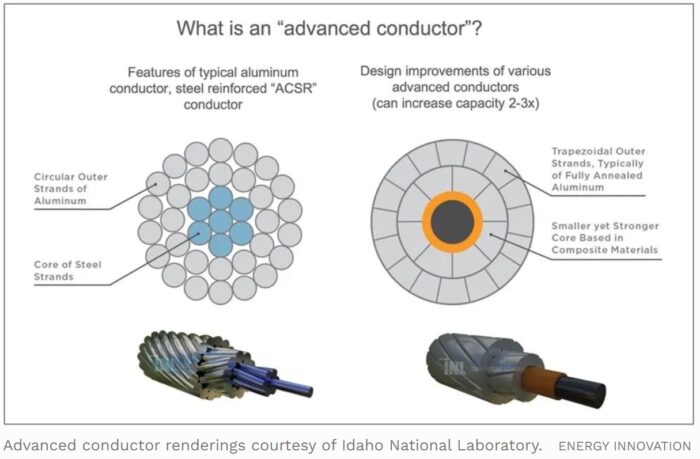Apr 11 2024
Reconductoring our Electrical Grid
 Over the weekend when I was in Dallas for the eclipse, I ran into a local businessman who works in the energy sector, mainly involved in new solar projects. This is not surprising as Texas is second only to California in solar installation. I asked him if he is experiencing a backlog in connections to the grid and his reaction was immediate – a huge backlog. This aligns with official reports – there is a huge backlog and its growing.
Over the weekend when I was in Dallas for the eclipse, I ran into a local businessman who works in the energy sector, mainly involved in new solar projects. This is not surprising as Texas is second only to California in solar installation. I asked him if he is experiencing a backlog in connections to the grid and his reaction was immediate – a huge backlog. This aligns with official reports – there is a huge backlog and its growing.
In fact, the various electrical grids may be the primary limiting factor in transitioning to greener energy sources. As I wrote recently, energy demand is increasing, faster than previously projected. Our grid infrastructure is aging, and mainly uses 100 year old technology. There are also a number of regulatory hurdles to expanding and upgrading the grid. There is good news in this story, however. We have at our disposal the technology to virtually double the capacity of our existing grid, while reducing the risk of sparking fires and weather-induced power outages. This can be done cheaper and faster than building new power lines.
The process is called reconductoring, which just means replacing existing power lines with more advanced power lines. I have to say, I falsely assumed that all this talk about upgrading the electrical grid included replacing existing power lines and other infrastructure with more advanced technology, but it really doesn’t. It is mainly about building new grid extensions to accommodate new energy sources and demand. Every resource I have read, including this Forbes article, give the same primary reason why this is the case. Utility companies make more money from expensive expansion projects, for which they can charge their customers. Cheaper reconductoring projects make them less money.
Other reasons are given as well. The utility companies may be unfamiliar with the technology, not want to retrain their workers, see this as “new technology” that should be approached as a pilot project, and may have some misconceptions about the safety of the technology. However, the newer powerlines have been used for over two decades, and Europe is way ahead of the US in installing it. These are hurdles that can all be solved with a little money and regulation.
Traditional power lines have a steel core with surrounding aluminum wires. Newer power lines have a carbon composite core with surrounding annealed aluminum. The newer cables are stronger, sag less, and have up to twice the energy carrying capacity as the older lines. Upgrading to the newer cables is a no-brainer.
The electrical grids are now the primary limiting factor in getting new clean energy online. But adding new power lines is a slow process. There is no single agency that can do it, so new permits have to go through a maze of local jurisdictions. Utility companies also fight with each other over who has to pay for what. And local residents create a NIMBY problem, pushing back against new power lines.
Reconductoring bypasses all of those issues, because it uses existing power lines and infrastructure. There are no new permits – you just do it.
In a way, we can take advantage of our past negligence. We have essentially been building new power lines to add more capacity, rather than updating lines. This means we have left ourselves an easy way to massively expand our grid capacity. There is already some money in the infrastructure bill and the IRA for grid upgrades, but the consensus seems to be that this is not enough. We likely need a new bill, one that provides the regulation and funding necessary for a massive reconductoring project in the US. And again, the best part about this approach is that it can be done fast. We can get ahead of our increasing energy demand, and make the grid more resilient and safer.
This will not solve all problems. Some new additions will still need to be made for the grid, not only to expand overall capacity, but to bring new locations onto the grid, both sources and users of electricity. Those necessary grid expansions, however, can take priority, as we won’t need to build new towers just to add capacity to existing routes.
Yet again it seems we have the technology we need to successfully make the transition to a much greener energy sector. We just need to get our act together. We need to make some strategic investments and changes to regulations and how we do things. There are about 3,000 electric utility companies in the US who are responsible for grid upgrades. There are also many state and local jurisdictions. This is an impossible patchwork of entities that need to work together to improve, update, and expand the grid, and so the result is a slow bureaucratic mess (which should come as a surprise to no one). There are also some perverse incentives, such as the way utility companies are reimbursed for capital expenditures.
Again I am reminded of my experience with telehealth – we had the technology, and the advantages were all there. But we could not seem to make it happen because of bureaucratic hurdles. Then COVID hit, and literally overnight we made it happen. If we see the threat of climate change with the same urgency, we can similarly removed logistical hurdles and make a green transition happen.






